Local, regional, and national organizations send joint letter to Congress asking for action at Buxton Beach
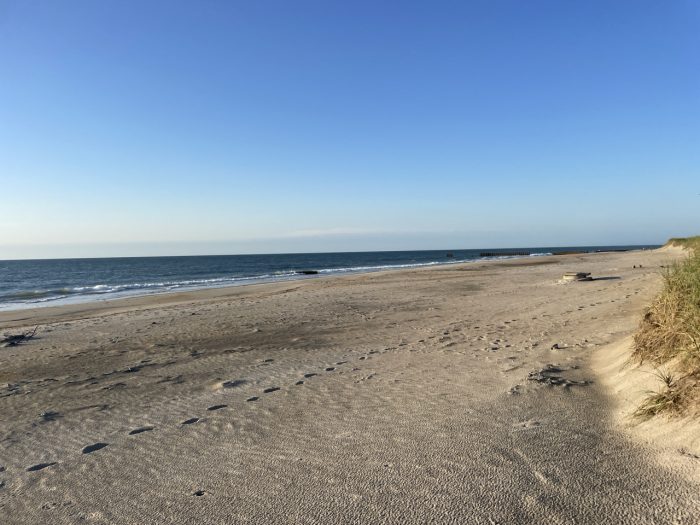
Nearly a dozen local, regional, and national organizations came together to send a detailed letter to Congress that requested immediate remediation for a roughly 500-yard section of Buxton Beach.
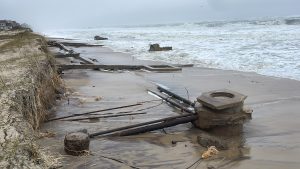
The letter, dated June 5, outlines the history of the former military base, which has been an area of concern since two offshore hurricanes brushed the Outer Banks in September 2023.
The back-to-back storms, (Franklin and Idalia), resulted in heightened erosion, and exposed infrastructure from the site’s former military activities, as well as occasional petroleum smells.
The letter is specifically addressed to two members of the House Subcommittee on Water Resources and Environment, but was also sent to 23 additional congressmen, senators, and other stakeholders who are connected to the clean-up efforts required for Buxton Beach.
The letter specifically requests that the subcommittee conducts oversight of the issue, and if necessary, authorize the U.S. Army Corps of Engineers (Corps) to remediate the environmental and public safety hazards, and restore the shoreline to its pristine condition.
“We are writing to call your attention to an ongoing crisis involving petroleum pollution, large building fragments, septic system remnants, and other physical and chemical hazards abandoned along the shoreline of Cape Hatteras National Seashore at the site of former U.S. Navy and U.S. Coast Guard facilities in Buxton,” reads the June 5 letter.

“We are concerned that the [Corps] has not remediated the dangers left behind by the Department of Defense [DoD] and by its insistence that it lacks the authority to do most of the work necessary to restore the site.
“According to the Corps’ own website, ‘DoD is responsible for the environmental restoration (cleanup) of properties that were formerly owned by, leased to or otherwise possessed by the United States and under the jurisdiction of the Secretary of Defense prior to October 1986. Such properties are known as Formerly Used Defense Sites or FUDS… [and] the U.S. Army Corps of Engineers executes the FUDS Program on behalf of the U.S. Army and DoD.
“The Buxton Beach Access site where the ongoing petroleum contamination, building debris, and other chemical and physical hazards are located has a well-documented history as a FUDS, which is summarized on this National Park Service website.
“Briefly, the U.S. Navy developed and used the approximately 50-acre site at the end of Old Lighthouse Road in Buxton, within Cape Hatteras National Seashore, as a submarine monitoring station from 1956 to 1982 under a Special Use Permit issued by the National Park Service [NPS]. Then the U.S Coast Guard occupied and used portions of the site as a logistical, communication, medical, and supply support center between 1984 and 2010 under a Memorandum of Understanding with the NPS.

“The original Special Use Permit granted to the Navy by the NPS in 1956 included the condition that the Navy must ‘remove all structures, foundations, and pavements, and clean up and restore the site prior to or immediately following termination of use.’
“Although the Corps has done some remediation work at the site in the past, the beach and coastal dunes at the site have, predictably, eroded in recent years, resulting in the foreseeable exposure of a considerable amount of infrastructure debris as well as petroleum contamination of the National Seashore beach…
“The exposed debris and petroleum are compelling evidence that the Navy did not completely remove all the pollution it was obliged to remove and restore the site as required by those documents.”
According to SELC representatives, the letter was drafted and sent based on communications with the Corps which indicated that the agency would take minimal action when it came to fully remediating Buxton Beach.
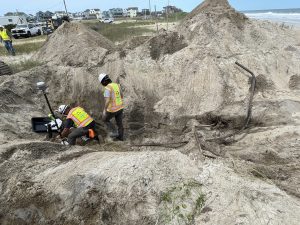
In May 2024, the Corps removed a skinny 70-foot-long pipe that was thought to be a potential source of at least some of the recent petroleum smells.
Following the pipe removal, the Corps also conducted testing in the immediate area to see if petroleum-contaminated soils were still present. (As of June 13, those test results are not yet available.)
However, outside of site visits for testing, this is the extent of the remediation efforts that have been conducted by the Corps since September 2023.
As of June 2024, there are no immediate plans to remove any of the additional debris, or the foundations of leftover military structures, including the foundation of the former Terminal Building where submarine detection operations were conducted.
“We were motivated to send the letter to Congress by the various communications from the Corps, including the Corps’ April 30 letter to us attached as Exhibit 5, a call from the Corps’ lawyer on May 7, and the statements the Corps representatives made at the public meeting on May 14,” stated Julie Youngman, senior attorney for SELC, in an email to the Island Free Press.
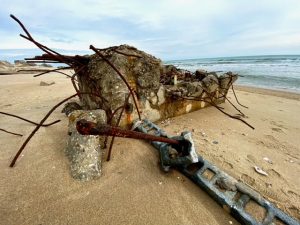
In the aforementioned April 30 letter to the SELC, the Corps stated that they had investigated the reports of petroleum on the shoreline but were unable to find a source, or determine “whether the petroleum relates to a prior DoD activity.”
Regarding remnants of old Navy infrastructure, the Corps stated that their authority was “limited to only demolishing and removing any unsafe buildings and structures that existed at the time the property was transferred from DoD control.”
“Those communications all made it clear that the Corps was disavowing any responsibility arising out of the 1956 Special Use Permit issued by the NPS to the Navy and any responsibility for the building remnants and other physical debris, and was likely also going to disavow any responsibility for any chemical contamination besides any petroleum they found in the immediate vicinity of a 70-foot section of pipe excavated on May 14,” stated Youngman.
The consensus among the multiple organizations that signed the letter – and the Buxton community in general – is that there is a big logical gap when it comes to responsibility. Basically, the issues that have resurfaced over the past nine months should have been properly and fully addressed roughly 40 years ago, but they weren’t.

For example, the Environmental Assessment and Finding of No Significant Impact for Defense Environmental Restoration Program from July 1985 outlines the demo work required, based on the conditions set in that 1956 Special Use Permit from the NPS. It states that “The project involves demolition of 2 concrete buildings, foundations and attendant fences, and pavements.”
One of these two buildings was the Terminal Building, and according to a 1986 Army Corps of Engineers statement of work for demo and removal of buildings, utilities, etc., the required work was completed.
However, as evident during a number of winter and spring storms, the foundation of the Terminal Building was not fully removed.
This is why the Buxton Beach situation has become a flashpoint, even though the environmental issues affect a tiny, three-tenths-of-a-mile section of the 75-mile-long Cape Hatteras National Seashore. It’s also a primary reason why so many organizations have joined the call to have a complete remediation occur, including the Buxton Civic Association
“We felt that the most effective way to achieve real action and resolution of the issues at the Buxton beach site was ultimately going to be political pressure,” said Buxton Civic Association Board Member Heather Gray Jennette. “While we are incredibly proud of the work that our Civic Association has done, and appreciative of the efforts of the [Dare] County Commissioners, the SELC has resources and experience that we believe can expedite this matter.
“We felt that signing off on the letter to Congress, along with many other organizations who hold a stake in this issue, was the next, right thing to do in our fight to restore our beach.
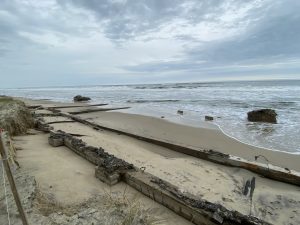
“If this letter does not yield the response we hope it will, we will continue to explore further options to make it happen.”
The organizations and agencies that signed the June 5 letter included the Southern Environmental Law Center, Dare County, North Carolina Coastal Federation, Buxton Civic Association, The Coalition to Protect America’s National Parks, Outer Banks Chamber of Commerce, Outer Banks Visitors Bureau, Outer Banks Association of Realtors, Surfrider Foundation, National Parks Conservation Association, and Outer Banks Forever.
To read the June 5 letter in its entirety, click here.
For more information on Buxton Beach, and how to get involved
- The Buxton Civic Association meets the first Thursday of every month at the old Buxton Volunteer Fire Department building beside Burrus Field. Developing info from the Buxton Civic Association (BCA) can be accessed via the organization’s new website at Buxtoncivic.com or through the BCA’s official Facebook page.
- The public can also join the ongoing email and letter-writing campaign, which was launched in mid-March by Buxton community members.
- Visitors who encounter a fuel smell or fuel sheens while visiting the Buxton shoreline near Old Lighthouse Road should call the National Response Center at 1-800-424-8802 to report the encounter. Include the date, time, location, and basic details of what was seen or smelled, and do not call if you have not experienced the issue first-hand, or have not been physically affected.
- Remember that while the environmental issues at Buxton Beach are considered to be a public safety and environmental hazard, just three-tenths of a mile of the shoreline is closed, out of 75 miles of National Seashore. In short, the public can still visit and enjoy Buxton, and Hatteras Island in general. The primary concern is that this issue needs to be addressed now, before it potentially becomes a larger problem.











